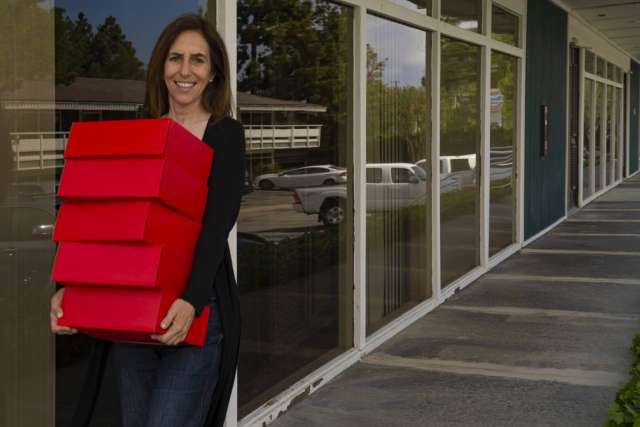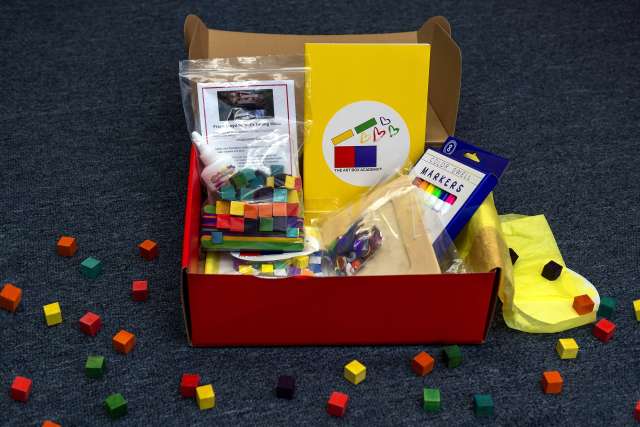Early in life, Lauren Dennis-Perelmuter found her passion in the totality of the arts.
She majored in fine arts at UC Santa Barbara and then studied textile design at the prestigious Otis Art Institute.
Later, she made an innovative approach to arts education her livelihood, establishing a mobile education operation that brought instruction and creative materials into schools.
When the COVID-19 pandemic brought a halt to that, she conceived a new, even more altruistic outlet for her enthusiasm — bringing boxes containing interactive art exercises to hospitalized children through her business, The Art Box Academy.
Through the Art Boxes, young patients — including children at UCLA Mattel Children’s Hospital — who are deprived of traditional outlets for recreation, can find creative expression and education in lessons on everyone from the old masters to Frank Lloyd Wright to Mondrian.
"It's joyful, it's sensory, and then there's a huge distraction therapy component," Dennis-Perelmuter said. "There's a lot of screen time inside and outside of hospitals, so just making sure that there's some hands on learning and joy, that's really important."
Kelli Carroll, director of the Chase Child Life Program at UCLA Mattel Children's Hospital, said hospital art projects provide the young patients with "non-pharmaceutical pain management."
"When your mind is not on your physical self and you're putting your energy into being creative, it often helps with pain management, especially with kids," Carroll said. "Kids can wholly get into something, and it takes their mind off of not only where they are, but how they're feeling."

Carroll said children often do not have the vocabulary to tell hospital staff exactly how they feel. But what they cannot say in words, she said, they can express through art.
"We find out a lot when we give kids art supplies," Carroll said. "Sometimes they surprise us. Kids that we think were coping really well – we find out something that is completely opposite of what our eyes might tell us. And sometimes kids feel so much more safe and comfortable expressing through something that is not the spoken word."
At the start of the pandemic, Carroll said, the recreation room at the children's hospital was closed to gatherings, so staff set up a virtual meeting place for the young patients on Zoom, where they've been using Dennis-Perelmuter's Art Boxes.
"They Zoom in from their room, and they all have an iPad," Carroll said. "They can just jump right in and they can really interact with all of the senses and see the other kids in the hospital. The social aspect of it has been really good because it's Zoom, because they can actually see other kids. And the Art Boxes have been great for it. They're self-contained so we don't have to be running around gathering up materials."
Dennis-Perelmuter's Art Box inspired by Frank Lloyd Wright includes building blocks and other materials to recreate the architectural masterpiece Fallingwater, was especially popular, Carroll said.
"The box came with a little bit of the background on how Frank Lloyd Wright was creative, himself, and did things that nobody else did when it came to building structures," Carroll said. "The kids hear that story and they hear that there was this grown-up and he was outside the box, so to speak. It allows for them to feel a little bit of safety and empowerment to be outside the box themselves, so they can do what they want to do and what they might imagine, which is really great."
At the end of each session, the children show off their projects to a round of applause, Carroll said.
For Dennis-Perelmuter, her decision to start the The Art Box Academy was deeply personal. She said the project was created in part by her own experience spending time with her youngest son after he was hospitalized following a near-drowning incident at a day camp five years ago.

"He was nine at the time and he held his breath too long and passed out at the bottom of a pool at the camp," Dennis-Perelmuter said.
Luckily, a camp lifeguard spotted the boy and pulled him to safety. He was transported to a hospital where he was kept for observation.
"The whole experience in the hospital was just unbelievable," Dennis-Perelmuter said. "They were putting IVs in my son and he was scared."
Once he had stabilized, a hospital staffer arrived with glitter wands and LEGOs.
"I'm sitting there at the worst moment of my life, learning how important these activities and distractions are in a crisis," Dennis-Perelmuter said. "I was like, 'Wow.'”
"The child can work on (the Art Boxes) at any time, but when the family visits, it can be something that brings them together."
Tina Daunt is the author of this article.



